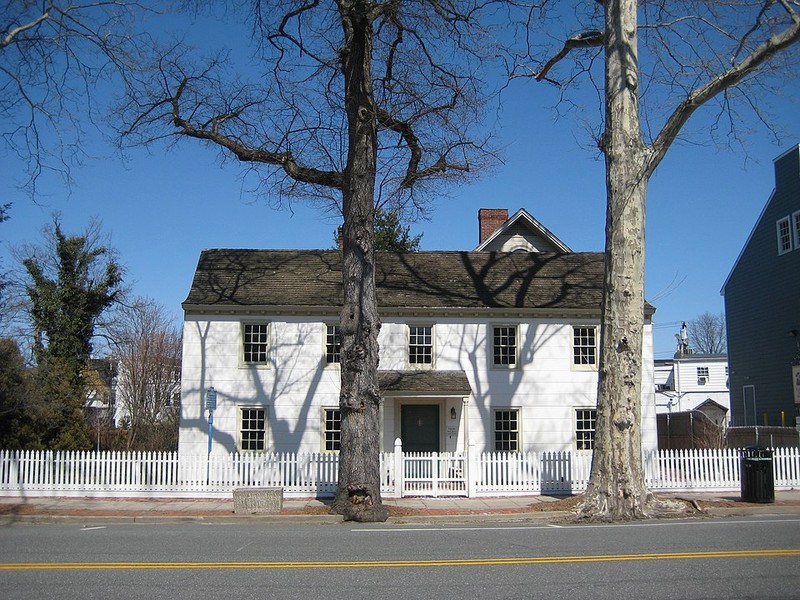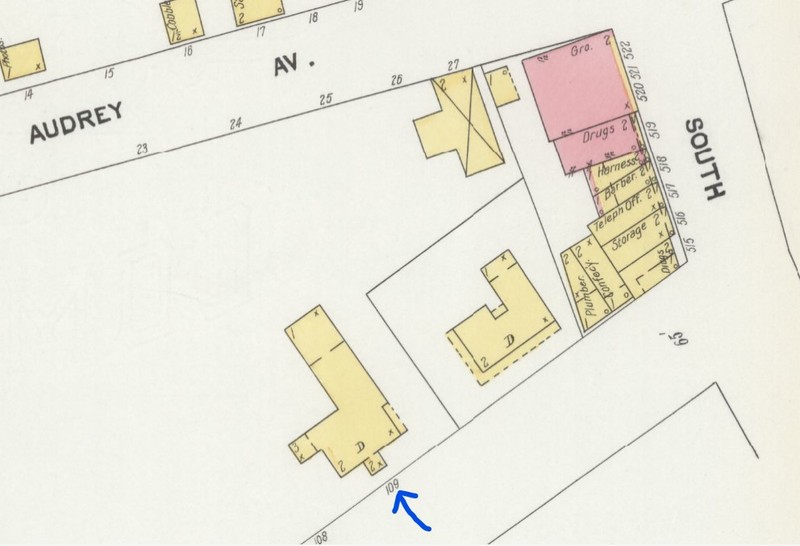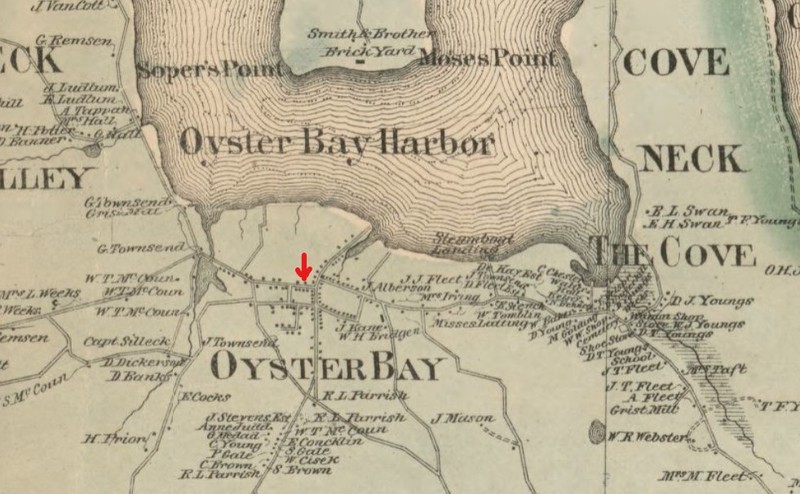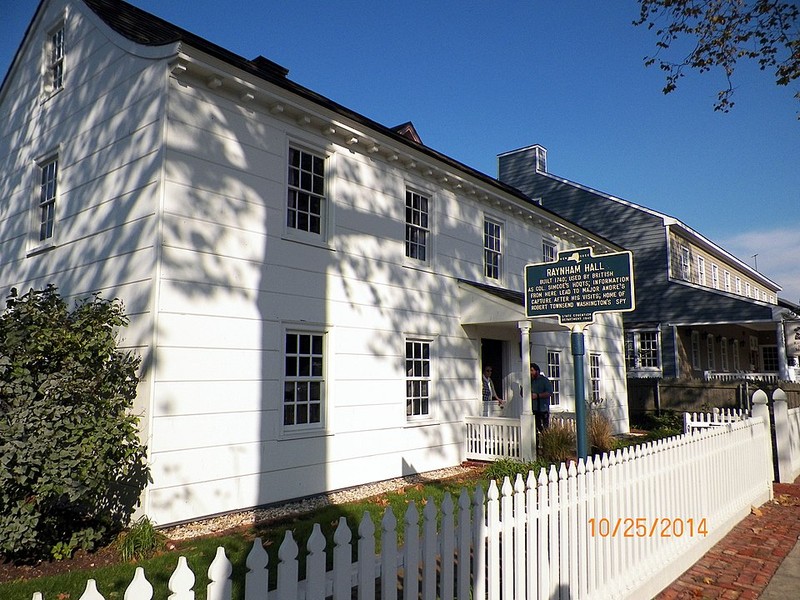Raynham Hall Museum
Introduction
Text-to-speech Audio
Images
Front facade of Raynham Hall Museum in 2008 photo (Idoysterbay)

Raynham Hall (blue arrow) on 1902 Sanborn map of Oyster Bay (p. 2)

Raynham Hall (red arrow) on 1859 map of Oyster Bay area of Queens County (Henry Francis Walling)

View of W side & front of Raynham Hall; historical marker by front entry porch (Rhonda McCloughan 2014)

Backstory and Context
Text-to-speech Audio
The man that owned Raynham Hall before Samuel Townsend's 1738 purchase was named Thomas Weedon. Since Weedon worked as a carpenter, it is possible he was the builder of the original four-room house. Samuel Townsend was a young man from Jericho, New York; his brother, Jacob, moved in next door. The brpthers operated a trading/ shipping business from the nearby harbor; they owned five ships by the late 1760s. Samuel also operated a general store. The house eventually became home to Samuel, his wife Sarah Stoddard, and their eight children. Samuel also had quarters on the property for twenty enslaved persons.
During the American Revolution, about half of Oyster Bay's residents were on the British side of the conflict. When the Battle of Long Island was lost by the Patriots in 1776, British soldiers arrested Samuel townsend for being a Patriot. Thomas Buchanan, the son-in-law of Samuel's brother Jacob and a partner in the Townsend shipping business, paid a ransom to free Samuel after he was forced to sign an oath of allegiance to the King. Loyalist Rangers occupied Raynham Hall from 1778 to 1779. The Samuel Townsend family shared the home with the troops. A letter written in 1779 by John Simcoe, one of the British soldiers, to one of Samuel Townsend's daughters, Sarah ("Sally"), asked her to be his Valentine; the letter survives and is said to be the first recorded Valentine's Day letter in America. Maybe the feelings were mutual - Sally lived the rest of her life in the "Old Homestead" and never married; she died in 1842 at age 82; her father had passed away in 1790. Her brother, Robert, spent some time during the Revolution as a spy for the American side, while living away from the family home. Robert returned to Oyster Bay and lived the bachelor life in the house until he died at age 85 in 1838. Their sister, Phebe, married a doctor from Connecticut named Ebenezer Seely, and the couple also made their home in the Townsend house.
Another son of Samuel, Solomon (I), was a merchant in New York City; his son, Solomon (II), acquired the Oyster Bay home from Dr. Seely in 1851. Solomon (II) married a cousin, Helene DeKay, in 1849. The wealthy merchant and member of the New York State Legislature and his wife raised six children in the Oyster Bay home, after building a new wing and other improvements in 1851. The home went from eight to twenty-two rooms! Solomon (II) died in 1880; Helene passed away in 1895 and the house was left to a daughter, Maria Townsend. When Maria died in 1908, her brothers Solomon (III) and Maurice were still living in the house. To settle Maria's estate, the house was sold in 1912 to Edward Nicholls Townsend Jr. (a grandson of Solomon II). A niece of Helene - Julia Weeks Cole - bought the home in 1914 and converted it into a tea room and a meeting place for the Oyster Bay Historical and Genealogical Society. Miss Coles sold the house in 1933 to the Daughters of the American Revolution (DAR). Upkeep of the building and tea room proved costly, and the DAR sold the property to the Town of Oyster Bay in 1947. Early on during Town of Oyster Bay ownership, the front part of Raynham Hall was restored to its pre-Victorian configuration. A museum, focused on the Revolutionary War era, opened in the house in 1953. The museum now focuses on the many years of Townsend family ownership as well.
Sources
Raynham Hall Museum. 1740-1776: Before the Revolution, History. January 1st 2020. Accessed March 30th 2021. https://raynhamhallmuseum.org/1740-1776-before-the-revolution/.
Raynham Hall Museum. The Revolution, History. January 1st 2020. Accessed March 30th 2021. https://raynhamhallmuseum.org/the-revolution/.
Raynham Hall Museum. Robert Townsend & The Culver Spy Ring, History. January 1st 2020. Accessed March 30th 2021. https://raynhamhallmuseum.org/robert-townsend-the-culper-spy-ring/.
Raynham Hall Museum. America's First Valentine, History. January 1st 2020. Accessed March 30th 2021. https://raynhamhallmuseum.org/americas-first-valentine/.
Raynham Hall Museum. Raynham Hall Since 1850, History. January 1st 2020. Accessed March 30th 2021. https://raynhamhallmuseum.org/raynham-hall-since-1850/.
Raynham Hall Museum. Who's Who, History. January 1st 2020. Accessed March 30th 2021. https://raynhamhallmuseum.org/whos-who/.
https://commons.wikimedia.org/wiki/Category:Raynham_Hall_Museum#/media/File:Oyster_Bay_Raynham_Hall_2008.jpg
https://www.loc.gov/item/sanborn06156_003/
https://www.loc.gov/item/2013593266/
https://commons.wikimedia.org/wiki/Category:Raynham_Hall_Museum#/media/File:Raynham_Hall,_Oyster_Bay,_NY.jpg
